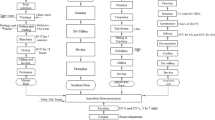Abstract
The protein quality of several breakfast foods which had wheat, corn, rice or skim milk as the principal source of protein was evaluated, singly and in combination with milk, casein or fababean. Commercially available breakfast foods with a range in protein content of 4.5 – 31.0% were administered at equal nitrogen levels to the fungusAspergillus flavus Link ex Fr. in a liquid medium. The dry mycelial weight produced after 72 hours of shaking was taken as an index of protein quality. Two products, coded BWW and IBM were found to be close to milk and fababean in their protein quality. Fungal biomass registered a 2–3 fold increase when breakfast foods were mixed with milk or methionine-supllemented fababean meal. None of the products tested were found to be superior to casein, but fungal biomass produced on foods mixed with casein was generally lower than on those mixed with milk or fababean meal.
Zusammenfassung
Die Proteinqualität von verschiedenen Frühstückmitteln welche Weizen, Maiz, Reis oder Magermilch als Grundproteinmaterial hatten, wurden abgeschätzt, entweder allein oder in Kombinationen mit Milch, Casein oder Fababohnen. Die kommerziellen Frühstückmittel mit einem Proteingehalt vom 4.5 – 31.0% wurden auf gleichem Stickstoffgehalt dem PilzeA. flavus im Flussigen Nährmedium zugesetzt. Das Gesamttrockengewicht des Mycels nach 72 stündigem Schütteln diente als Index für die Proteinqualität. Zwei Produkte bezeichnet als BWW und IBM waren im Proteinqualität Milch und Fababohnen ähnlich. Es gab eine 2–3 fache Pilzbiomassgewichtzunahme wenn Frühstückmittel mit Milch oder Methionineergänztem Fababohnenmehl gemischt wurden. Keine getesteten Produkte waren hochwertiger als Casein, aber Pilzbiomass entwickelt auf eine Mischung von Frühstückmitteln mit Casein ein geringeres Gewicht im Vergleich zu Mischungen mit Milch oder Fababohnenmehl.
Resume
La qualité des protéines des aliments du petit déjeuner qui contient du blé, du mais, du riz, et du lait comme source principale a été énuméré uniquement, et avec une combinaison de lait, casein au fababeau. Ces produits sont disponible dans le commerce pour aliment de petit déjeuner avec une variation de protéine contenant 4.5 – 31.0% sont administré avec une degré de nitrogène au fongusAspergillus flavus Link ex Fr. et une portion liquide. Le pois dy mycelicum sêché produit après 72 heures de continuelle mouvement a été pris comme index de la qualité des protéines. Deux produits, nommé par code BWW, et IBM ont été découvert d'être rapproché du lait et du fababeau dans la qualité des protéines. La masse des fongus biologique a enregistré que les aliments du petit déjeuner mélangé avec du lait ou des suppléments methionine de fababeau renfermant une augmentation de 2–3. Aucun de ces produits analysé ne furent fondé supérieur à la caséine mais la masse des fongicides biólogique produite avec les aliments mélangé avec de la caseine était généralement plus basse que celle qui était mélangé avec du lait ou avec des aliments de fababeau.
Similar content being viewed by others
References
Hackler, L.R. (1972). Nutritional evaluation of protein quality in breakfast foods.Cereal Chem. 49:677.
Kaldy, M.S. & Kasting, R. (1974). Amino acid composition and protein quality of eight fababean cultivars.Can. J. Plant Sci. 54:868.
Kaul, A.K. (1973). Mutation breeding and crop protein improvement. In: Nuclear techniques for seed protein improvement. IAEA, Vienna STI/PUB/320,1.
Kaul, A.K. & Sharma, T.R. (1974). Rapid determination of nitrogen content in grain-meal samples with alkali-phenol reaction, manually and with an autoanalyzer.Z. Anal. Chem. 280:133.
Marquardt, R.R. & Campbell, L.D. (1973). Raw and autoclaved faba beans in chick diets.Can. J. Animal Sci. 53:741.
Marquardt, R.R., Campbell, L.D., Stothers, S.C. & McKirdy, J.A. (1974). Growth responses of chicks and rats fed diets containing four cultivars of raw or autoclaved faba beans.Can.J. Animal Sci. 54:177.
Mohyuddin, M. & Skoropad, W.P. (1972). Sensitization of Aspergillus flavus spores to gamma radiation by halogens.Can. J. Bot. 50:1431.
Mohyuddin, M., Kaul, A.K., Sharma, T.R. & Niemann, E.G. (1976a). Use of two fungal strains as test organisms for the evaluation of relative nutritive value in cereals and legumes.Qual. Plant.-Pl. Fds. hum. Nutr. 25 (3–4):317.
Mohyuddin, M., Lewis, A.J. & Bowland, J.P. (1978). Use of Aspergillus flavus to evaluate relative nutritive value of barley cultivars intended for incorporation in animal diets.Qual. Plant. Pl. Fds. hum. Nutr. 28,1:19–27.
Mohyuddin, M., Sharma, T.R., Kaul, A.K. & Niemann, E.G. (1976b). Use of Aspergillus flavus to evaluate the relative nutritive value in cultivars of rye, wheat and triticale.J. Sci. Fd. Agric. 27:943.
Mohyuddin, M., Sharma, T.R., Dhar, P. & Niemann, E.G. (1977a). Nutritive value of some wheat varieties assessed with Aspergillus flavus in comparison to rat feeding experiments.Qual. Plant.-Pl. Fds. humn. Nutr. 27 (3–4):249.
Mohyuddin, M., Sharma, T.R. & Niemann, E.G. (1977b). Nutritive value of rye and wheat breads assessed with Aspergillus flavus.J. Agric. Food Chem. 25:200.
Mohyuddin, M. & Bowland, J.P. (1977c). Nutritive value of some turkey diets and high protein meals assessed with the fungus Aspergillus flavus.Qual. Plant.-Pl. Fds. humn. Nutr. Accepted, QP 879.
Nesheim, R.O. (1977). Food industry requirements for rapid methods of protein quality assessment.Nutr. Reports Int. 16:157.
Sarwar, G., Sosulski, F.W. & Bell, J.M. (1975). Nutritive value of field peas and fababean proteins in rat diets.J. Inst. Can. Sci. Technol. 8:109.
Stothers, S.C. (1974). Fababeans in swine production. Proc. First National Fababean Conf., Winnipeg, Manitoba, Canada. p. 90.
Stott, J.A. & Smith, H. (1966). Microbiological assay of protein quality with Tetrahymena pyriformis W. 4. Measurement of available lysine, methionine, arginine and histidine.Br. J. Nutr. 20:663.
Wilson, B.J. & McNab, J.M. (1972). The effect of autoclaving and methionine supplementation on the growth of chicks given diets containing field beans. (Vicia faba).Br. Poul. Sci. 13:67.
Author information
Authors and Affiliations
Rights and permissions
About this article
Cite this article
Mohyuddin, M., Mazza, G. Evaluation of protein quality in breakfast foods usingAspergillus flavus . Plant Food Hum Nutr 28, 251–259 (1978). https://doi.org/10.1007/BF01093955
Issue Date:
DOI: https://doi.org/10.1007/BF01093955




